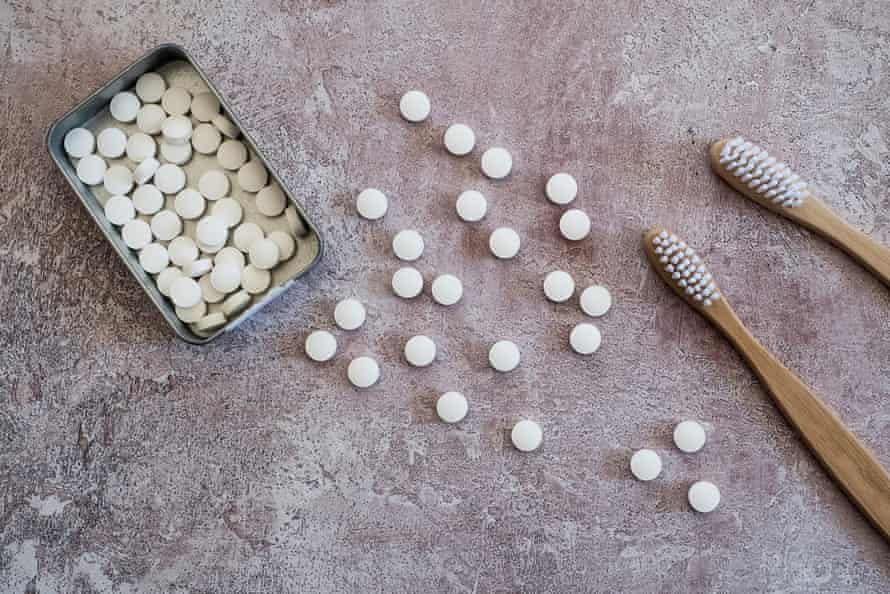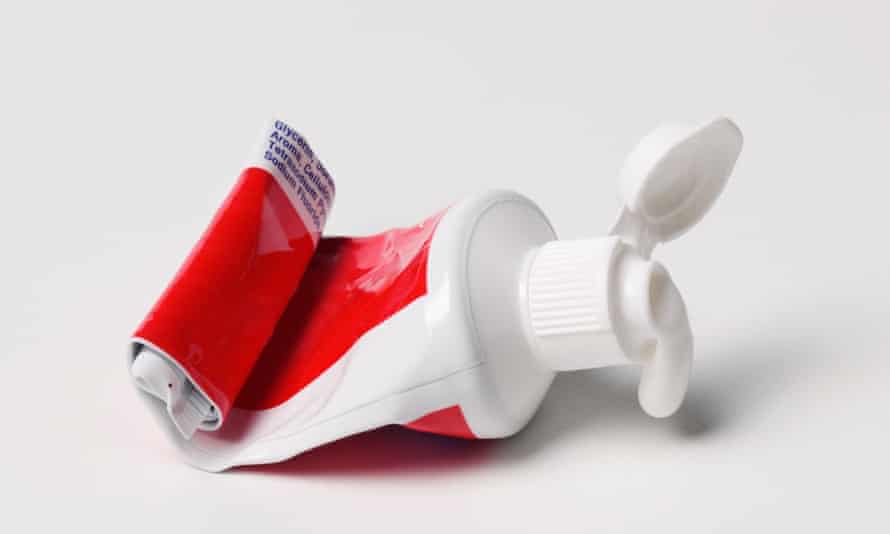I’ve always enjoyed that scene in The Fifth Element where Milla Jovovich puts two tablets in a bowl, places the bowl in the microwave, there’s an instant ping!, and out comes a perfectly cooked roast chicken. There’s something pleasingly futuristic and Jetsonian about tablets that encapsulate real-world phenomena, like chicken. Or toothpaste.
Yes, toothpaste now comes in tablet form. No more herniated squeezing or complex tube origami to extract the last stubborn iota of paste. The future of dental care is bite-size. Maybe.
Technically, toothpaste tablets aren’t toothpaste at all. They’re a compressed powder derived from stuff like xylitol (a natural sweetener that also fights oral bacteria), calcium carbonate (a chemical compound found in limestone and snail shells) and sodium bicarbonate (standard baking soda). They often also contain cream of tartar, a common household bleach-alternative made from tartaric acid, not to be confused with the seafood sauce.

The market for toothpaste tablets is valued at about $20 million, but it’s expected to almost double by 2026. That’s small minty potatoes, compared to the $18 billion global toothpaste industry, which is why it’s surprisingly hard to buy the stuff in person. Supermarkets, chemists and chain grocers are still selling toothpaste in tubes, like it’s 1995. Eventually I managed to track down some tablets in a vegan, organic grocery store. The glass bottle promises: “The most versatile, eco-friendly toothpaste available.”
This is the big selling point for toothpaste tablets. Not only are they portable and heat resistant – you can leave them in a hot car and they won’t melt into some kind of gross spearmint epoxy – they’re much more sustainable too.
Since it first appeared in 1898, tubular toothpaste has been a bit of an environmental catastrophe. “Conventional toothpaste tubes aren’t easy to recycle,” says Dr Sahar Farzadnia from the independent eco-labelling program, Good Environmental Choice Australia. “They’re usually made from different types of plastics, including the cap, and they’re sometimes laminated with a metal layer, which can be another big barrier to recycling. This means tubes can end up in landfill and fragment over time.”

While enterprises like TerraCycle offer collection-points for oral care products, plenty still end up in landfill. Moreover, many toothpastes, roughly half according to anti-plastic waste NGO Beat the Microbead, also contain microplastics – tiny indestructible plastic polymers that get spat down the sink and washed into the food chain.
Toothpaste tablets, by comparison, are usually sold in glass jars or recyclable plastic bottles. They’re made from things you might find in the back of the average pantry. Depending on your tooth-brushing regimen, one bottle of 60 tablets should last about a month.
But there’s an elephant in the bathroom. Do toothpaste tablets actually work?
One ingredient you won’t find in many tablets is fluoride, a proven cavity-buster that’s been standard in toothpaste since Procter & Gamble released Crest in 1956. Crest’s original ad campaign featured Norman Rockwell paintings of toothy, corn-fed American children and the caption: “Look, Mom! No cavities!”
“There’s a lack of scientific evidence on how good toothpaste tablets are, in terms of oral health,” says Dr James Fernando, dentist and research fellow at Melbourne Dental School. “Toothpaste should be able to remove plaque, prevent gum disease and tooth decay, and fluoride is a big part of that. There’s not much clinical data out there on toothpaste tablets, and to be honest, I couldn’t find any lab data either.”
Fernando says the lack of fluoride in many tablet brands is worrying, and even though some do contain useful active ingredients, like sodium bicarbonate and xylitol, without further study there’s no way to know how much of that goodness ends up in your teeth. “Put it this way,” he says. “I personally wouldn’t be telling patients, ‘Hey, use this product’.”
I tried three brands of tablet, and none advertised fluoride as an ingredient. In fact, in this space, many toothpaste tablets actively flaunt their fluoride-free status, and that’s a worry because research suggests fluoride-free oral care products, often marketed as “natural”, tend to increase cavities. One exception to this is Danish brand DentTabs, which does contain fluoride and is widely available online in Australia.
So, how do you actually use toothpaste tablets? Toothy Tabs, from British cosmetics brand Lush, directs users to “nibble one tab to form a toothpaste and then use a wet toothbrush to clean as normal.” Most tablets feature similar crush-brush-and-rinse instructions.
You can literally chew toothpaste tablets on-the-go, like breath mints, but I found the effect to be underwhelming and weird. The tablet dissolves around your gums in a blast of eye-watering menthol, then disappears, like chewing minty paracetamol.
The initial “nibbling” phase with all three brands I tried was, to be frank, pretty unpleasant and vaguely medicinal. Compressed powder tablets do not masticate well. Two brands also left some kind of gritty, mineral residue behind (not a big deal – a few rinses and it washes away).
The overall experience doesn’t quite live up to my Fifth Element fantasies, but I’m sure toothpaste in 1898 wasn’t much fun either.
If tablets are good for the planet, and evidence for their cavity-preventing capacity materialises, I’m happy to go tubeless. Next step: roast chicken.
from Lifestyle | The Guardian https://ift.tt/37dUJyo
via IFTTT

comment 0 Comment
more_vert